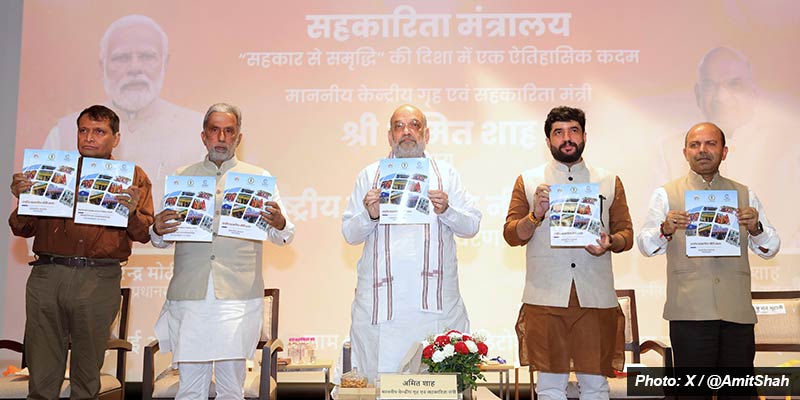- India
- Jul 26
- Sreesha V.M
National Cooperation Policy 2025
• Union Home and Cooperation Minister Amit Shah unveiled the National Cooperation Policy on July 24.
India has more than 8.44 lakh cooperative societies
• Cooperation is embedded in the fabric of Indian society, which drives the spirit of collaboration to achieve common socio-economic goals.
• A cooperative is an autonomous association of persons, united voluntarily to meet their common economic, social, and cultural needs and aspirations through a jointly owned and democratically member-controlled enterprise.
• It embodies a synergistic approach — leveraging the efficiency, innovation, and market dynamism while championing the equity, inclusivity, and social welfare principles.
• This fusion offers a strong alternative to the current economic systems, providing a model that prioritises both economic growth and collective well-being.
• India is home to more than one-fourth of the world’s cooperatives, with about one-third of its rural population directly connected to them as members for their diverse socio-economic needs.
• At present, India has more than 8.44 lakh cooperative societies spanning 30 sectors, including credit, housing, marketing, dairy, fisheries, and more — functioning as essential instruments for rural credit, self-employment, and collective economic strength.
• About 13 crore people are directly associated with them and 91 per cent villages in India have some form of cooperatives working in them.
• A separate Ministry of Cooperation was formed in the year 2021 to develop the rural economy of the country, to strengthen the cooperative movement and to take it to every household.
National Cooperation Policy 2025
• The previous policy on cooperatives was released in 2002. It focused on the basic dimensions of efficiently organising economic activities by cooperatives.
• Driven by globalisation and technological advancements, it is essential to revisit the policy and formulate a new one to suit the evolving requirements of the cooperative sector and to ensure the sustainability of this sector in the current economic scenario.
• National Cooperation Policy, 2025 was formulated by a 40-member committee chaired by former Union Minister Suresh Prabhu.
• It aims to propel the cooperative sector to contribute three times more to the country’s GDP, supporting India's goal of becoming a developed nation by 2047.
• The policy was developed after extensive consultations, with the committee receiving around 750 suggestions from stakeholders. The final framework was prepared in consultation with the Reserve Bank of India and NABARD.
• The policy specifically targets entry into tourism, taxi services, insurance, green energy and other sectors to enhance diversification and increase member incomes.
The policy mission will be implemented through six strategic pillars:
i) Strengthening foundation.
ii) Promoting vibrancy.
iii) Making cooperatives future-ready.
iv) Promoting inclusivity and deepening reach.
v) Entering new and emerging sectors.
vi) Shaping the young generation for cooperative growth.
• The central focus remains the welfare of each cooperative member, with plans to transform cooperative enterprises into professionally managed, transparent, technology-enabled, vibrant and responsive economic entities.
• A major objective is to bring 50 crore citizens, who are either not members or are inactive in the cooperative sector, into active participation.
• Additionally, there is a target to increase the number of cooperative societies by 30 per cent.
• There will be at least one primary cooperative unit in every panchayat, which could be a Primary Agricultural Credit Society (PACS), Primary Dairy Cooperative, Primary Fisheries Cooperative, Primary Multipurpose PACS, or any other primary unit. These units will also help create more employment opportunities for youth.
• Efforts will be made to establish five model cooperative villages in every tehsil across the country through state cooperative banks.
• A detailed roadmap has been prepared for ground-level implementation of the policy, supported by two dedicated committees that will oversee the rollout across different regions.
• To maintain policy relevance and effectiveness, the government has put in place a review system that mandates necessary legal amendments every decade, creating a framework for continuous adaptation to changing socio-economic conditions in rural India.
• The policy includes key elements aimed at bringing significant transformation in the socio-economic structure of villages and ensuring that technology reaches even the smallest cooperative units over the next two decades. The computerisation of processes will completely change operational methods, leading to increased transparency and efficiency.
(The author is a trainer for Civil Services aspirants.)

